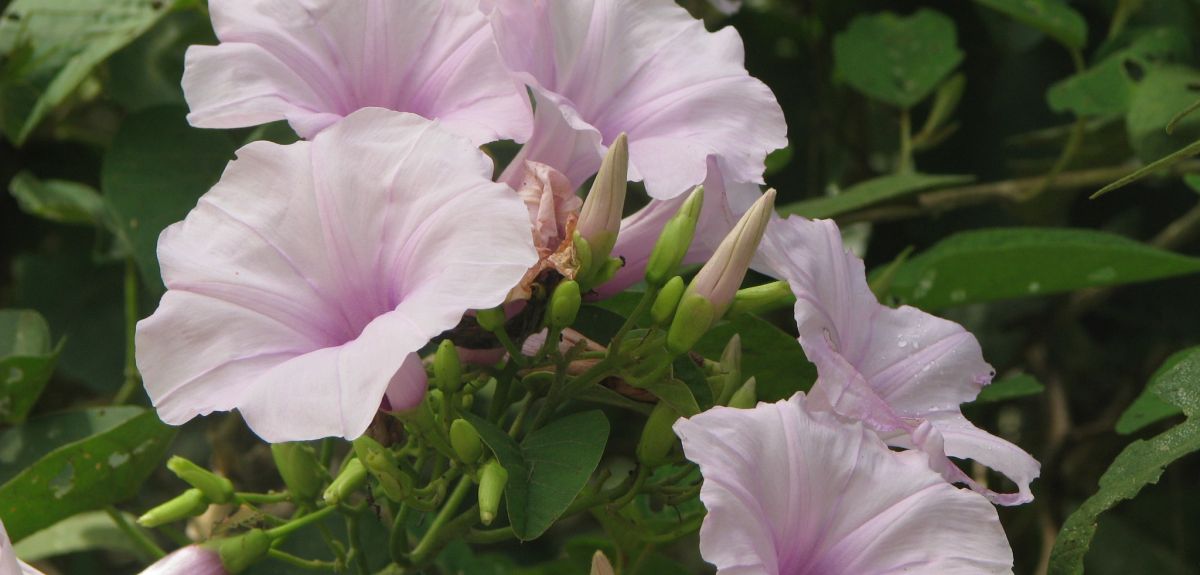
Credit: JRI Wood
What’s the story Morning Glory? Taxonomy, evolution and sweet potatoes
Scientists at the University of Oxford reveal that the sweet potato and its storage root originated at least 2 million years ago — that is, not only before agriculture but also long before modern humans appeared on Earth.
The scientists' research indicates that the storage root was an already-existing trait that predisposed the plant for cultivation and not solely the result of human domestication, as previously thought. This discovery, published in Nature Plants, is part of a comprehensive monographic study of the morning glories, the biggest study of this group of plants to date, which also contributes important insights to the taxonomy and evolution of this megadiverse group of plants.
The researchers also discovered that sweet potato is not the only species of morning glory that produces storage roots. In fact at least 62 other species in the group also produce these underground organs, some of them as big as those of the sweet potato and many also edible.
Dr Pablo Muñoz, from Oxford's Department of Plant Sciences, whose PhD thesis formed a significant part of the paper, said: ‘Most other studies trying to understand the evolution of the sweet potato assumed that its storage root is a product of domestication by humans whereas this study demonstrates that storage roots evolved many times independently in different species including sweet potato before humans.’
The plant genus Ipomoea, commonly known as morning glories, is one of the largest groups of flowering plants in the world. It includes over 800 species, including many ornamental plants and one of the most important crops for human consumption: the sweet potato (Ipomoea batatas). However, despite their importance and widespread distribution, most species of morning glories are very poorly known and have never been studied across their entire geographical range, hindering the understanding of this important group of plants.
Researchers at the University of Oxford’s Department of Plant Sciences have led the first comprehensive monographic study of the morning glories at a global scale. It is a long-term collaboration with colleagues at the International Potato Center, in Peru, Oregon State and Duke Universities in the US and the Royal Botanic Garden Edinburgh. Their results include the description of 63 new species (almost 10% of the species known in the whole genus) and the identification of a large number of synonyms — entities described in different places under different names that are, in reality, the same species.
Their methods could offer a solution to the massive backlog in documenting and describing the bulk of the world’s plant species.
The scientists demonstrate how a monographic taxonomic study, carried out at a global scale, can make massive contributions to our understanding of the diversity existing in poorly known groups of organisms. By working out the evolution of the morning glories, they were also able to investigate several questions pertaining to the origin and evolution of the sweet potato.
The research uses herbarium specimens — dried plants preserved in botanical gardens, museums and other institutions — for both morphological comparative studies and molecular analyses. Herbarium specimens constitute an unparalleled resource with which to address the study of inadequately known groups of plants and is the only feasible way to study megadiverse tropical groups across their entire distribution.
Lead author, Professor Robert Scotland, said: ‘We hope this study acts as a catalyst in demonstrating the scale of progress that can be achieved. Taxonomy has often been perceived as a merely descriptive science, a continuation of the work carried out by 18th and 19th century naturalists and no longer necessary.
‘However, we believe that an accurate, up-to-date taxonomy is necessary to tackle the biodiversity crisis. A large percentage of tropical plant species are so poorly known that, in practice, they are invisible to conservation studies. Taxonomy is the science that underpins biology and provides our basic knowledge of what species there are and where they live. Our study demonstrates the potential of taxonomy, through the integration of morphological studies and molecular analyses, to contribute to understanding much of the plant diversity existing on Earth.’
 Oxford and GSK launch £50million immuno-prevention programme to advance novel cancer research
Oxford and GSK launch £50million immuno-prevention programme to advance novel cancer research
 Study shows plants are more likely to be ‘eavesdroppers’ than altruists when tapping into underground networks
Study shows plants are more likely to be ‘eavesdroppers’ than altruists when tapping into underground networks
 Former UK Prime Minister Rishi Sunak to join Blavatnik School of Government’s World Leaders Circle
Former UK Prime Minister Rishi Sunak to join Blavatnik School of Government’s World Leaders Circle
 Oxford researchers advocate for comprehensive framework to study AI's impact on youth mental health
Oxford researchers advocate for comprehensive framework to study AI's impact on youth mental health
 New Sutton Hoo research links Anglo-Saxons to Byzantine military campaigns in Syria
New Sutton Hoo research links Anglo-Saxons to Byzantine military campaigns in Syria